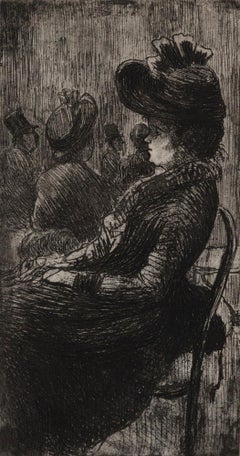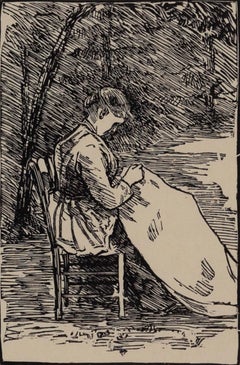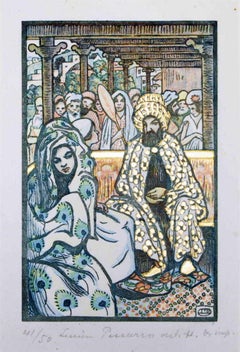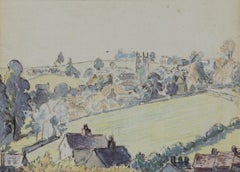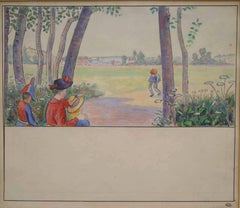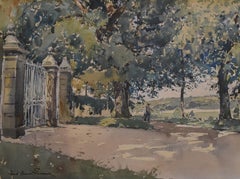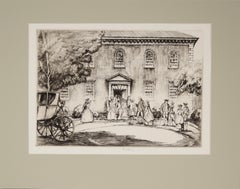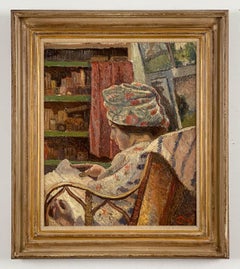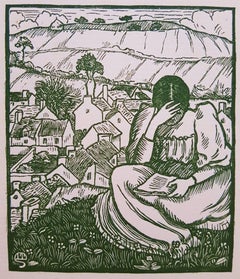Lucien Pissarro Art
to
7
1
Overall Width
to
Overall Height
to
3
5
2
1
4
2
1
4
4
3
3
2
1
1
4
4
4
3
2
8
7,786
4,999
2,504
1,372
6
6
Artist: Lucien Pissarro
Une Femme Assise by Lucien Pissarro - Etching
By Lucien Pissarro
Located in London, GB
Une Femme Assise by Lucien Pissarro (1863-1944)
Etching
23 x 13 cm (9 x 5 ¹/₈ inches)
Stamped lower right, L.P. and numbered lower left, 10/20
Provenance: John Bensusan Butt
Private...
Category
1890s Impressionist Lucien Pissarro Art
Materials
Etching
Woman Embroidering (Nini) by Lucien Pissarro - Woodcut
By Lucien Pissarro
Located in London, GB
Woman Embroidering (Nini) by Lucien Pissarro (1863-1944)
Woodcut
15 x 10 cm (5 ⁷/₈ x 4 inches)
Stamped with initials lower right
Numbered lower left, 18/20
Provenance: Private Colle...
Category
20th Century Post-Impressionist Lucien Pissarro Art
Materials
Woodcut
In the Harem - Woodcuts by Lucien Pissarro - 1909
By Lucien Pissarro
Located in Roma, IT
Woodcut print realized by Lucien Pissarro to illustrate Gerard de Nerva's Hitoire de la Reine du Matin et des Soliman Princes des Genies.
Hand signed
Edition of 50 copies (41/50)
Category
Early 1900s Modern Lucien Pissarro Art
Materials
Paper, Woodcut
In the Harem - Woodcuts by Lucien Pissarro - 1909
By Lucien Pissarro
Located in Roma, IT
Woodcut print realized by Lucien Pissarro to illustrate Gerard de Nerva's Hitoire de la Reine du Matin et des Soliman Princes des Genies.
Hand signed
Edition of 50 copies (41/50)
Category
Early 1900s Modern Lucien Pissarro Art
Materials
Paper, Woodcut
Wotton-under-Edge by LUCIEN PISSARRO - Watercolour, drawing, art, landscape
By Lucien Pissarro
Located in London, GB
Wotton-under-Edge by LUCIEN PISSARRO (1863-1944)
Ink, watercolour and crayon on paper
14.6 x 18.5 cm (5 3⁄4 x 7 1⁄4 inches)
Signed with monogram and dated lower left, 1920 Inscribed ...
Category
1920s Post-Impressionist Lucien Pissarro Art
Materials
Crayon, Ink, Watercolor
Apparition des Premiers Habitants by Lucien Pissarro
By Lucien Pissarro
Located in London, GB
Apparition des Premiers Habitants by Lucien Pissarro
Watercolour on paper
23 x 26.5 cm (9 x 10 ⅜ inches)
Signed with monogram, lower right
Executed mid 1880s – 1890
This work is ac...
Category
Late 19th Century Lucien Pissarro Art
Materials
Watercolor, Paper
Le Défilé Royal (Illustration for Voyage au Pays des Pommes) by Lucien Pissarro
By Lucien Pissarro
Located in London, GB
Le Défilé Royal (Illustration for Voyage au Pays des Pommes) by Lucien Pissarro (1863-1944)
Watercolour on paper
22.5 x 26 cm (8 ⅞ x 10 ¼ inches)
Signed lower left with monogram
This work is accompanied by a letter of authenticity from Colin Harrison, Senior Curator of European Art at the Ashmolean Museum, Oxford.
Provenance
Mr Ian Robertson
Exhibition
London, Leicester Galleries, Memorial Exhibition of Lucien Pissarro's Work, Part II, 1947, No. 60 (catalogued as La Procession)
Artist biography
Born on the 20th February 1863, Lucien Pissarro was the eldest son of the Impressionist painter Camille Pissarro. Coached from a young age by his father and in the frequent company of figures such as Cézanne, Gauguin and Monet, it is no surprise that Lucien chose to pursue an artistic career. While he is best known as a landscape painter, Lucien was also a printmaker, wood engraver and printer of fine books, occasionally painting still lifes and portraits of his family.
Lucien first visited England in 1870 with his family when fleeing the Franco-Prussian war. It was the beginning of a great love affair with the country. He decided to move permanently to England in 1890, becoming an English citizen in 1916. Until then he had worked as a landscape painter and book illustrator in France. During this period he met and worked with painters such as Paul Signac, Georges Seurat and Vincent van Gogh. Moving simultaneously in Impressionist and Neo-Impressionist circles, Lucien exhibited Pointillist paintings with his father in the last Impressionist exhibition in 1886. In the same year he was one of the first artists to exhibit in the “Salon des Indépendants” as a Neo-Impressionist.
Despite his close relationship with his father, as revealed in their correspondence, Lucien showed remarkable independence of mind in his approach to his art. While Lucien was trained by his father, the influence the artists had on one another was reciprocal. Thanks to his relationship with Seurat and Signac, Lucien encouraged Camille to experiment with Pointillism, a characteristic of the Neo-Impressionist group.
Lucien’s move to England in 1890 allowed him greater freedom to pursue his interest in book illustration and printing. There Lucien and his wife Esther established the Éragny Press, named after the Normandy village where his family lived since 1884. The Éragny Press was principally notable for creating aesthetically pleasing books and paved the way for the development of European book art. Lucien’s illustrations for these books demonstrate his talent and command of colour.
Nevertheless, Lucien always considered painting his primary concern, particularly landscape painting. Continuing the tradition of the Impressionists, Lucien was a plein-air painter who liked to work outdoors and study the subject directly from nature. His landscapes reveal his fascination for the effects of weather and light. The contemporary art critic Frank Rutter described Lucien as a master of colour, writing in 1922: “there is no man living who has a more profound knowledge of the science of colour, or a more discriminating eye for its observation in nature.” Rutter was also struck by Lucien’s respect for his subject, nature itself: “Each canvas is wrought with a quiet perfection that conceals its art and is eloquent of the tender emotion which the loveliness of nature inspires in the artist.”
It is clear from Rutter’s praise that Lucien’s contemporaries were impressed by his combination of English and French artistic traditions. Unsurprisingly, he became associated with artistic groups that drew inspiration from the Impressionists, including the New English Art Club, with whom he exhibited in 1904, the Fitzroy Street Group in 1907 and the Camden Town Group in 1911. To his English contemporaries Lucien represented a direct link to the Impressionist Masters. His influence can be recognised in the work of British artists such as Spencer Gore, Harold Gilman...
Category
19th Century Post-Impressionist Lucien Pissarro Art
Materials
Paper, Watercolor
Tenterden by Lucien Pissarro - Watercolour
By Lucien Pissarro
Located in London, GB
Tenterden by Lucien Pissarro (1863-1944)
Watercolour, ink, pen and coloured crayon
16.5 x 24 cm (6 ¹/₂ x 9 ¹/₂ inches)
Signed with monogram and titled lower right
Provenance: The Redfern Gallery...
Category
20th Century Post-Impressionist Lucien Pissarro Art
Materials
Ink, Pen, Watercolor, Crayon
Related Items
Paul Emile Lecomte (1877-1950) La Grille (The Gate), signed watercolor
By Paul Emile Lecomte
Located in Paris, FR
Paul Emile Lecomte (1877-1950)
La Grille (The Gate)
Signed lower left
Watercolor on paper
27 x 37 cm
In quite condition: yellowed by time, some stains
Framed: 43 x 53 cm
Paul Emile ...
Category
1930s Post-Impressionist Lucien Pissarro Art
Materials
Watercolor
Washington At Pohick Church - 1932 Etching On Paper
By Ernest David Roth
Located in Soquel, CA
Washington At Pohick Church - 1932 Etching On Paper
1932 black and white etching depicting George Washington at Pohick Church by Ernest David Roth (German, 1879-1964). George Washin...
Category
1930s American Impressionist Lucien Pissarro Art
Materials
Laid Paper, Etching
Window onto the Sea, Original Drawing, Contemporary Landscape, Architecture
Located in AIX-EN-PROVENCE, FR
Work : Original Drawing, Handmade Artwork, Unique Work. The work has been treated with UV-resistant varnish and it is not framed.
Medium : Watercolour, Soft Pastel and Oil based col...
Category
21st Century and Contemporary Impressionist Lucien Pissarro Art
Materials
Archival Paper, Color Pencil, Pastel, Watercolor
H 11.82 in W 11.82 in D 0.12 in
The Old Man and the Sea - Original Woodcut by Henri Riviere - Early 20th Century
By Henri Riviere
Located in Roma, IT
"The Old Man and the Sea" is an original xilograph on brown-colored paper, realized by Henri Riviere.
The state of preservation of the artwork is very good.
Sheet dimension: 24.5 x...
Category
Early 20th Century Post-Impressionist Lucien Pissarro Art
Materials
Woodcut
H 9.65 in W 24.02 in D 0.04 in
“Rocky Mountain Meadow”
By Werner Drewes
Located in Southampton, NY
Original watercolor on archival paper of a Rocky Mountain Meadow by the well known American artist, Werner Drewes. Signed lower right. Titled and dated 1956 on verso of sheet. Con...
Category
1950s American Modern Lucien Pissarro Art
Materials
Watercolor, Archival Paper
Summer Evening in Montreux, Lake Geneva, 1902
Located in Stockholm, SE
This exquisite watercolor by the Swedish artist Olle Hjortzberg (1872–1959) captures a serene view of Montreux, Switzerland, in July 1902. Known for his masterful use of color and li...
Category
Early 1900s Naturalistic Lucien Pissarro Art
Materials
Paper, Watercolor
"Train Station, " Max Kuehne, Industrial City Scene, American Impressionism
By Max Kuehne
Located in New York, NY
Max Kuehne (1880 - 1968)
Train Station, circa 1910
Watercolor on paper
8 1/4 x 10 1/4 inches
Signed lower right
Provenance:
Private Collection, Illinois
Max Kuehne was born in Halle, Germany on November 7, 1880. During his adolescence the family immigrated to America and settled in Flushing, New York. As a young man, Max was active in rowing events, bicycle racing, swimming and sailing. After experimenting with various occupations, Kuehne decided to study art, which led him to William Merritt Chase's famous school in New York; he was trained by Chase himself, then by Kenneth Hayes Miller. Chase was at the peak of his career, and his portraits were especially in demand. Kuehne would have profited from Chase's invaluable lessons in technique, as well as his inspirational personality. Miller, only four years older than Kuehne, was another of the many artists to benefit from Chase's teachings. Even though Miller still would have been under the spell of Chase upon Kuehne's arrival, he was already experimenting with an aestheticism that went beyond Chase's realism and virtuosity of the brush. Later Miller developed a style dependent upon volumetric figures that recall Italian Renaissance prototypes.
Kuehne moved from Miller to Robert Henri in 1909. Rockwell Kent, who also studied under Chase, Miller, and Henri, expressed what he felt were their respective contributions: "As Chase had taught us to use our eyes, and Henri to enlist our hearts, Miller called on us to use our heads." (Rockwell Kent, It's Me O Lord: The Autobiography of Rockwell Kent. New York: Dodd, Mead and Co., 1955, p. 83). Henri prompted Kuehne to search out the unvarnished realities of urban living; a notable portion of Henri's stylistic formula was incorporated into his work.
Having received such a thorough foundation in art, Kuehne spent a year in Europe's major art museums to study techniques of the old masters. His son Richard named Ernest Lawson as one of Max Kuehne's European traveling companions. In 1911 Kuehne moved to New York where he maintained a studio and painted everyday scenes around him, using the rather Manet-like, dark palette of Henri.
A trip to Gloucester during the following summer engendered a brighter palette. In the words of Gallatin (1924, p. 60), during that summer Kuehne "executed some of his most successful pictures, paintings full of sunlight . . . revealing the fact that he was becoming a colorist of considerable distinction." Kuehne was away in England the year of the Armory Show (1913), where he worked on powerful, painterly seascapes on the rocky shores of Cornwall. Possibly inspired by Henri - who had discovered Madrid in 1900 then took classes there in 1906, 1908 and 1912 - Kuehne visited Spain in 1914; in all, he would spend three years there, maintaining a studio in Granada. He developed his own impressionism and a greater simplicity while in Spain, under the influence of the brilliant Mediterranean light. George Bellows convinced Kuehne to spend the summer of 1919 in Rockport, Maine (near Camden). The influence of Bellows was more than casual; he would have intensified Kuehne's commitment to paint life "in the raw" around him.
After another brief trip to Spain in 1920, Kuehne went to the other Rockport (Cape Ann, Massachusetts) where he was accepted as a member of the vigorous art colony, spearheaded by Aldro T. Hibbard. Rockport's picturesque ambiance fulfilled the needs of an artist-sailor: as a writer in the Gloucester Daily Times explained, "Max Kuehne came to Rockport to paint, but he stayed to sail." The 1920s was a boom decade for Cape Ann, as it was for the rest of the nation. Kuehne's studio in Rockport was formerly occupied by Jonas Lie.
Kuehne spent the summer of 1923 in Paris, where in July, André Breton started a brawl as the curtain went up on a play by his rival Tristan Tzara; the event signified the demise of the Dada movement. Kuehne could not relate to this avant-garde art but was apparently influenced by more traditional painters — the Fauves, Nabis, and painters such as Bonnard. Gallatin perceived a looser handling and more brilliant color in the pictures Kuehne brought back to the States in the fall. In 1926, Kuehne won the First Honorable Mention at the Carnegie Institute, and he re-exhibited there, for example, in 1937 (Before the Wind). Besides painting, Kuehne did sculpture, decorative screens, and furniture work with carved and gilded molding. In addition, he designed and carved his own frames, and John Taylor Adams encouraged Kuehne to execute etchings. Through his talents in all these media he was able to survive the Depression, and during the 1940s and 1950s these activities almost eclipsed his easel painting. In later years, Kuehne's landscapes and still-lifes show the influence of Cézanne and Bonnard, and his style changed radically.
Max Kuehne died in 1968. He exhibited his work at the National Academy of Design, the Art Institute of Chicago, the Carnegie Institute in Pittsburgh, the Memorial Art Gallery of the University of Rochester, and in various New York City galleries. Kuehne's works are in the following public collections: the Detroit Institute of Arts (Marine Headland), the Whitney Museum (Diamond Hill...
Category
1910s American Impressionist Lucien Pissarro Art
Materials
Paper, Watercolor
Lunch on the Beach - 20th Century Watercolor of Dining on the Seafront
Located in Watford, Hertfordshire
This piece was created using watercolour and is in a swept composite frame under glass.
Keywords: Beach, art, arch, arches, sea, ocean, waiter, lunch, waiting, food, flag, boats, bl...
Category
20th Century Post-Impressionist Lucien Pissarro Art
Materials
Watercolor
H 13.78 in W 25.4 in D 1.97 in
Five at the Rail, View of Racetrack and Crowd, Saratoga Springs, New York
By Anne Diggory
Located in New York, NY
Anne Diggory (b. 1951)
Five at the Rail, Saratoga Springs Racecourse, New York, circa 1978
Watercolor on paper
4 3/4 x 6 inches
Initialed lower right: Dig...
Category
1970s Contemporary Lucien Pissarro Art
Materials
Paper, Watercolor
Oriental Landscapes With Palm Trees And Arab Houses. 1 Half Of The 20th Century.
Located in Firenze, IT
Fauve landscape with palm trees and Arab houses.
1 half of the 20th century.
Gouache paintings on cardboard.
Paintings is signed with monogram.
Dimensions with Passepartout 45.5cm x ...
Category
Early 20th Century Fauvist Lucien Pissarro Art
Materials
Paper, Watercolor, Gouache, Cardboard
H 14.57 in W 17.92 in
Les Amateurs d'Estampes
By Félix Vallotton
Located in Fairlawn, OH
Les Amateurs d'Estampes
Woodcut, 1892
Initialed in the plate lower left
Titled below image: "Gravure originale sur bois par F. Vallotton"
Reference: Valloton and Goerg 107c, with the...
Category
1890s Post-Impressionist Lucien Pissarro Art
Materials
Woodcut
Untitled, Edition - 5/5, Woodcut on Paper by Jogen Chowdhury "In Stock"
By Jogen Chowdhury
Located in Kolkata, West Bengal
Jogen Chowdhury - Untitled
Edition - 5/5
Woodcut on Paper
Print Size - 7.1 x 9.6 inches
Paper Size - 9.5 x 14.8 inches
2019
(Unframed & Delivered)
Modern Indian artist Jogen Chowdh...
Category
2010s Modern Lucien Pissarro Art
Materials
Paper, Woodcut
H 14.8 in W 9.5 in D 1 in
Previously Available Items
Girl Reading a Book
By Lucien Pissarro
Located in Sheffield, MA
Lucien Pissarro
French, 1863-1944
Girl Reading a Book
Oil on canvas
18 ¼ by 15 in. W/frame 24 ¼ by 21 in.
Signed lower right and dated 1907
Born in Pa...
Category
Early 1900s Post-Impressionist Lucien Pissarro Art
Materials
Oil
Girl Reading on a Hill
By Lucien Pissarro
Located in Saint Augustine, FL
An original color woodcut engraving on laid paper by French artist Lucien Pissaro (1863-1944) titled "Girl Reading on a Hill", 1891. Limited edition: unkn...
Category
1890s Impressionist Lucien Pissarro Art
Materials
Woodcut
Quand Elle Va Sur L'herbe (Girl Picking Flowers)
By Lucien Pissarro
Located in Saint Augustine, FL
An original four color woodcut engraving on laid paper by French artist Lucien Pissaro (1863-1944) titled "Quand Elle Va Sur L'herbe (Girl Picking Flowe...
Category
1910s Impressionist Lucien Pissarro Art
Materials
Woodcut
In The Field
By Lucien Pissarro
Located in Saint Augustine, FL
An original five color woodcut engraving on laid paper by French artist Lucien Pissaro (1863-1944) titled "In The Field", 1894. Comes from the 'Queen of...
Category
1890s Impressionist Lucien Pissarro Art
Materials
Woodcut
Le Grand Chêne
By Lucien Pissarro
Located in London, GB
56 x 46 cm (22 x 18 ⅛ inches)
Signed with Estate stamp and dated 1940, lower left
Provenance
Christie’s 4 August 1944 lot 140, Duke of Gloucester...
Category
20th Century Post-Impressionist Lucien Pissarro Art
Materials
Canvas, Oil
Lucien Pissarro art for sale on 1stDibs.
Find a wide variety of authentic Lucien Pissarro art available for sale on 1stDibs. You can also browse by medium to find art by Lucien Pissarro in paint, watercolor, crayon and more. Much of the original work by this artist or collective was created during the 20th century and is mostly associated with the Post-Impressionist style. Not every interior allows for large Lucien Pissarro art, so small editions measuring 4 inches across are available. Customers who are interested in this artist might also find the work of Jean-François Baudoin, Paul Emile Lecomte, and Louis Berthomme Saint-Andre. Lucien Pissarro art prices can differ depending upon medium, time period and other attributes. On 1stDibs, the price for these items starts at $1,500 and tops out at $95,000, while the average work can sell for $4,077.
